Art History Study Guide 2
1/108
There's no tags or description
Looks like no tags are added yet.
Name | Mastery | Learn | Test | Matching | Spaced |
|---|
No study sessions yet.
109 Terms
The pharaoh Narmer wears the high ______ shaped crown of Upper Egypt
White cone
The standard tomb type in early Egypt was the _______.
Mastaba
Egyptian painters and sculptors of the human figures, they did not sketch their subjects from life but applied a strict ______, or system of proportions.
Canon
The British Archaeologist _________, discovered the boy-king’s Tutankhamen tomb in 1922.
Howard Carter
Which work likely commemorates the unification of Upper and Lower Egypt?
The Narmer Palette.
In the 1st millenium BCE, Egypt’s southern neighbor called _______, or the kingdom of Kush.
Nubia
During the Myceneaen Period large-scale figural art on the Greek mainland was ______.
Rare
Mycenaeans’ architecture, they used post and lintel, corbeled arch, and the _______.
Relieving triangle
Eighth century BCE, Homer immortalized in the Iliad and the Odyssey the great war between the Greeks and the ______.
Trojans
In Middle Minoan period, Cretan potters fashioned sophisticated shapes using newly introduced potters’ ______.
Wheels
How does the kneeling statue of Hatshepsut indicate her status as pharaoh?
It portrays her wearing male pharaonic regalia showing her as king.
Alexander the Great invaded Egypt in the _____ century BCE
4th
As legend has it, King Minos of Crete’s step-son, a creature of half bull and half man is known as the ______.
Minotaur
Whose mortuary temple was located in Abu Simbel until it was moved in 1968 to save it from the Aswan Dam Reservoir?
Ramses II
Which of the following is depicted as a hawk or falcon and protector of pharaoh?
Horus
Which of the following is a palace on Crete?
Knossos
The Lion Gate is the gateway to:
Mycenae
Tomb paintings were created in which of the following techniques?
Fresco secco
The many columned hall found in an Egyptian temple is called a(n)
Hypostyle hall.
In about 3000 BCE, the conventions for representing the human figure that dominated Egyptian art until the end of the New Kingdom can be found in which of the following?
Narmer’s Palette
The ______, Greek excavators have been gradually uncovering for half a century, was buried in layers of volcanic ash.
city of Akrotiri (thera) (Cyclades)
Significant numbers of small marble figurines representing naked women with arms folded over abdomens have been found in:
Cycladic art/islands
Which of the following plants was commonly used to symbolize Upper Egypt
Lotus (or papyrus plants)
A tomb that resembles a truncated pyramid is called a _______.
Mastaba
What form of arch is above the lintel of the Lion Gate?
Corbeled arch
The guardian figure design of the Lion Gate can also be found in miniature on _____.
Gold signet rings or seals from Mycenae.
The god who is symbolic of the river Nile and who dies and is reborn each year is _____
Osiris
Which of the following describes a building technique commonly used in Egyptian temples?
Post and lintel construction with massive stone columns
Egyptians mummification process, the body was treated for 40 days with _____, used to dehydrate the body.
Natron
Third dynasty for King Djoser’s _____ is one of the oldest stone structures in Egypt.
Stepped Pyramid
The Egyptian pharoah, ________ claimed to be both the son and sole prophet of Aton
Akhenaton
What led the German amateur archaeologist, Heinrich Schliemann, to uncover Troy?
He followed Homer’s description in the Iliad
The Old Palace Period in Minoan art cfame to an end around 1700 BCE. What was the probable cause?
Fire destroyed the buildings most likely caused by an earthquake.
Architectural historians still employ the term ______ masonry to refer to the huge roughly cut stone blocks forming the massive fortification walls of Tiryns and other Mycenaean sites.
Cyclopian
The funerary practice of Myceneans, covering the faces of the dead with gold masks, recalls what other culture?
Egyptian funerary traditions
The _______ figurine depicted a nude woman, like many of their Stone Age predecessors in the Aegean, Mesopotamia, and western Europe represent nude women.
Cycladic
Egyptians’ frescos used the ______ system, or system of proportion to depict the human body
Canon
A magnificent mortuary temple was built at Deir el Bahri for which of the following pharaohs?
Hatshepsut
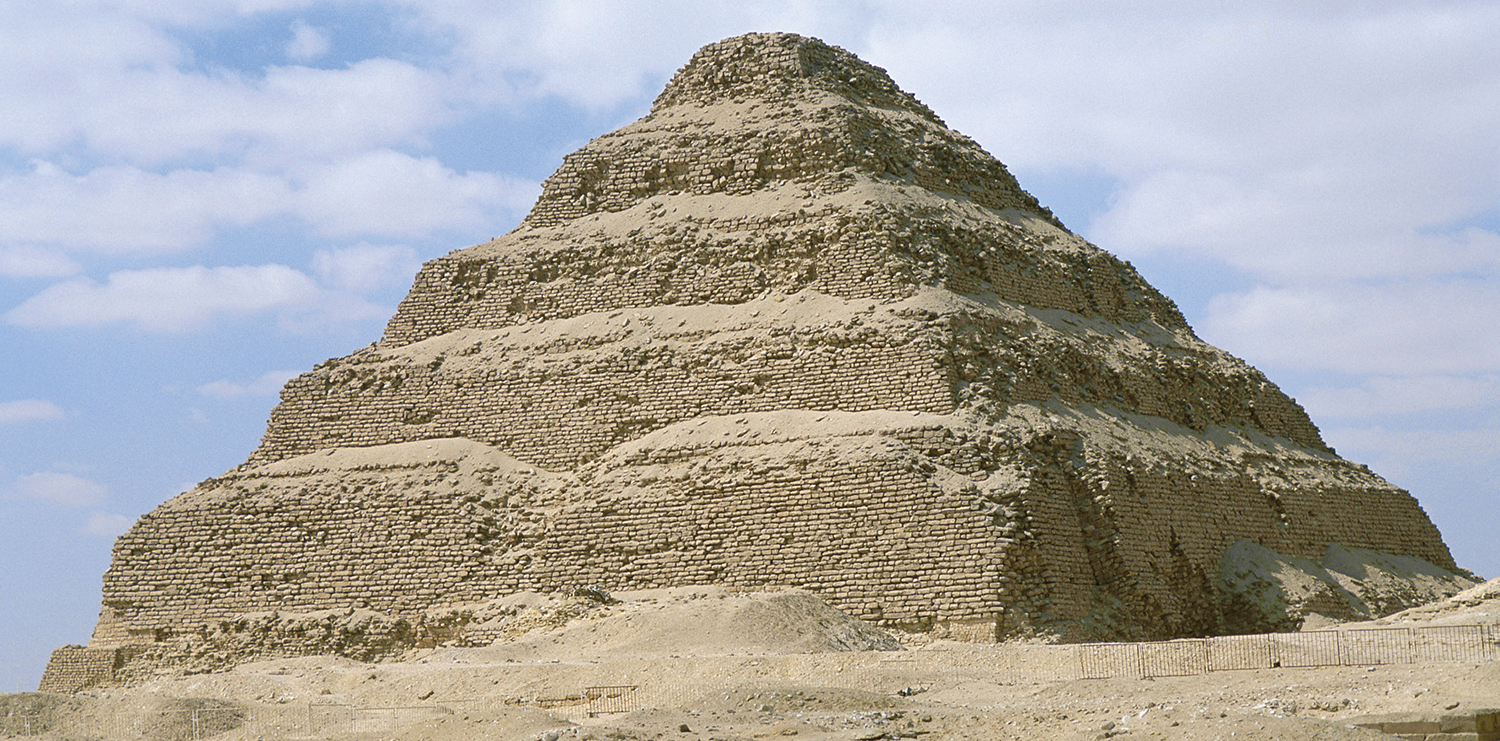
Who
Imhotep (for King Djoser)
Stepped Pyramid Of Djoser
Saqqara, Egypt
Early Dynastic periods (3rd Dynasty)
Built as a tomb to protect the mummified King Djoser and his possessions, and to symbolize his godlike power. Built with that design as a gigantic stairway for the king's Ka to ascend to the heavens and join the gods.
Built out of stone

What
Imhotep (for King Djoser)
Stepped Pyramid Of Djoser
Saqqara, Egypt
Early Dynastic periods (3rd Dynasty)
Built as a tomb to protect the mummified King Djoser and his possessions, and to symbolize his godlike power
Built out of stone

Where
Imhotep (for King Djoser)
Stepped Pyramid Of Djoser
Saqqara, Egypt
Early Dynastic periods (3rd Dynasty)
Built as a tomb to protect the mummified King Djoser and his possessions, and to symbolize his godlike power
Built out of stone

When
Imhotep (for King Djoser)
Stepped Pyramid Of Djoser
Saqqara, Egypt
Early Dynastic periods (3rd Dynasty)
Built as a tomb to protect the mummified King Djoser and his possessions, and to symbolize his godlike power
Built out of stone

Why
Imhotep (for King Djoser)
Stepped Pyramid Of Djoser
Saqqara, Egypt
Early Dynastic periods (3rd Dynasty)
Built as a tomb to protect the mummified King Djoser and his possessions, and to symbolize his godlike power
Built out of stone

What material
Imhotep (for King Djoser)
Stepped Pyramid Of Djoser
Saqqara, Egypt
Early Dynastic periods (3rd Dynasty)
Built as a tomb to protect the mummified King Djoser and his possessions, and to symbolize his godlike power
Built out of stone
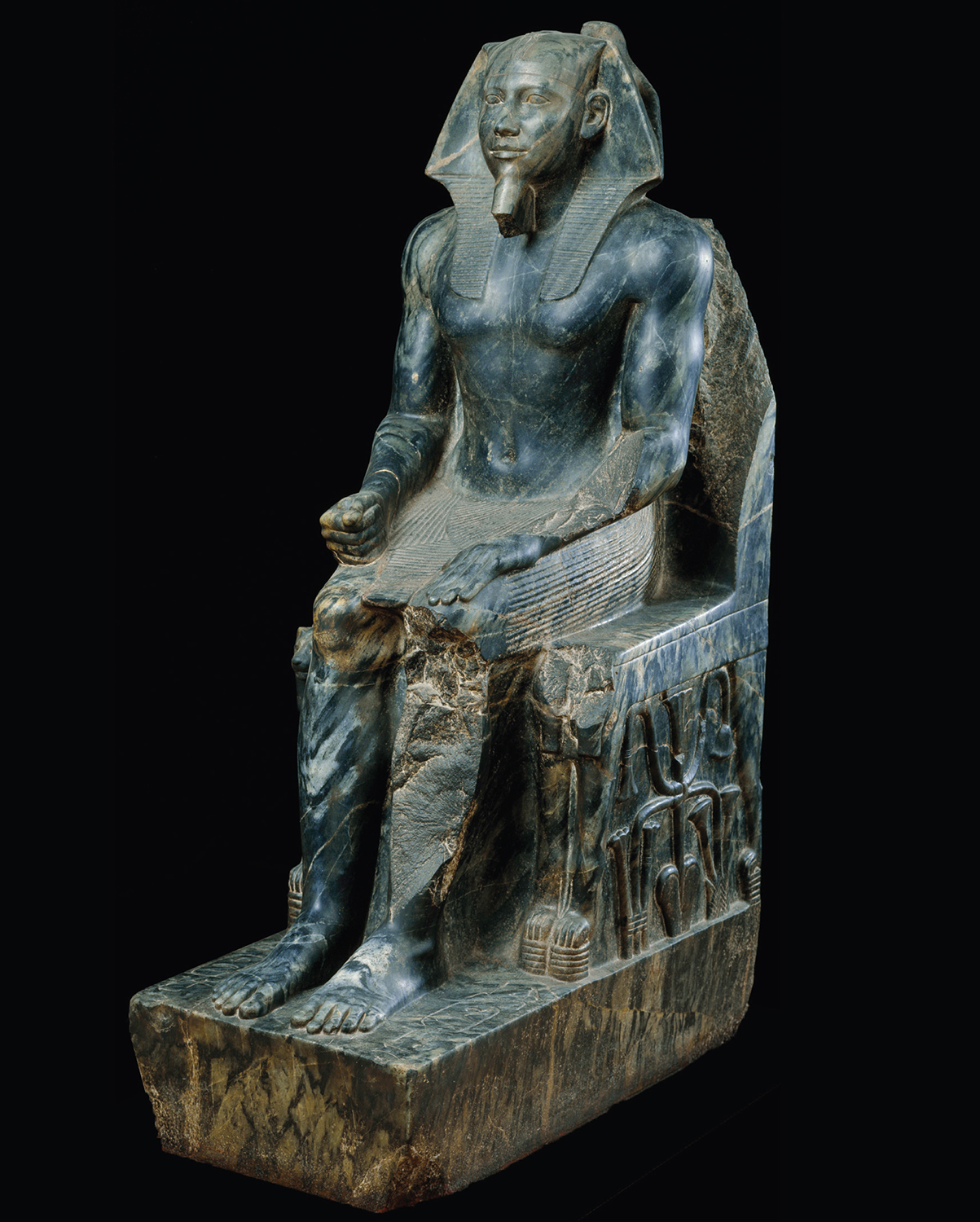
Who
King Khafre
Portrait from King Khafre’s Pyramid complex
Gizah, Egypt
Old Kingdom (4th dynasty)
To communicate the divine nature of his Egyptian kingship. And so the Ka knew where to reside
Diorite

What
King Khafre
Portrait from King Khafre’s Pyramid complex
Gizah, Egypt
Old Kingdom (4th dynasty)
To communicate the divine nature of his Egyptian kingship. And so the Ka knew where to reside
Diorite

Where
King Khafre
Portrait from King Khafre’s Pyramid complex
Gizah, Egypt
Old Kingdom (4th dynasty)
To communicate the divine nature of his Egyptian kingship. And so the Ka knew where to reside
Diorite

When
King Khafre
Portrait from King Khafre’s Pyramid complex
Gizah, Egypt
Old Kingdom (4th dynasty)
To communicate the divine nature of his Egyptian kingship. And so the Ka knew where to reside
Diorite

Why
King Khafre
Portrait from King Khafre’s Pyramid complex
Gizah, Egypt
Old Kingdom (4th dynasty)
To communicate the divine nature of his Egyptian kingship. And so the Ka knew where to reside
Diorite

What material
King Khafre
Portrait from King Khafre’s Pyramid complex
Gizah, Egypt
Old Kingdom (4th dynasty)
To communicate the divine nature of his Egyptian kingship. And so the Ka knew where to reside
Diorite
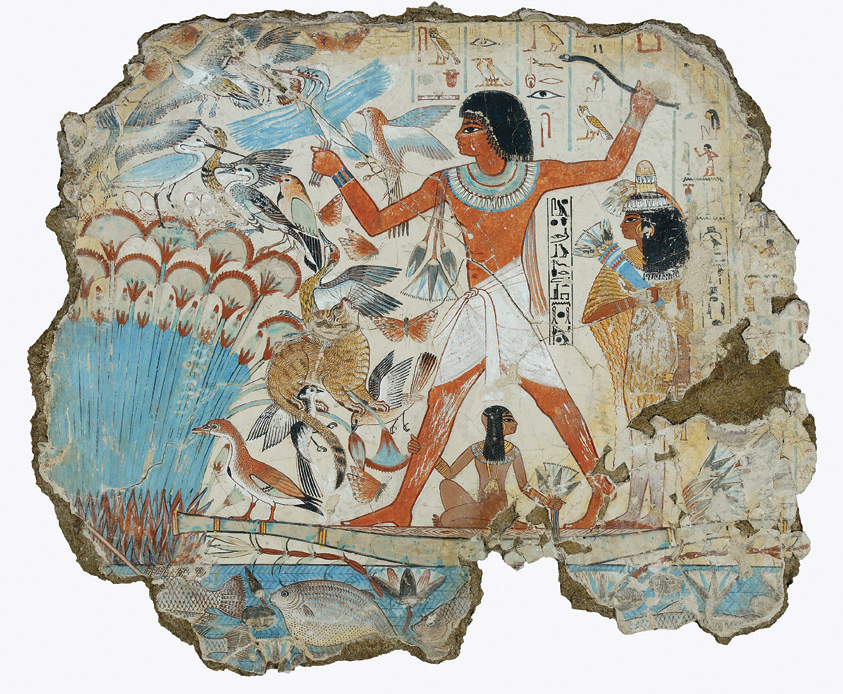
Who
Nebamun and his wife and daughter
Fragmentary mural of them hunting for fowl
Tomb of Nebamun, Thebes, Egypt
New Kingdom (18th dynasty)
To show he is enjoying his recreation in the afterlife
Fresco Secco

What
Nebamun and his wife and daughter
Fragmentary mural of them hunting for fowl
Tomb of Nebamun, Thebes, Egypt
New Kingdom (18th dynasty)
To show he is enjoying his recreation in the afterlife
Fresco Secco

Where
Nebamun and his wife and daughter
Fragmentary mural of them hunting for fowl
Tomb of Nebamun, Thebes, Egypt
New Kingdom (18th dynasty)
To show he is enjoying his recreation in the afterlife
Fresco Secco

When
Nebamun and his wife and daughter
Fragmentary mural of them hunting for fowl
Tomb of Nebamun, Thebes, Egypt
New Kingdom (18th dynasty)
To show he is enjoying his recreation in the afterlife
Fresco Secco

Why
Nebamun and his wife and daughter
Fragmentary mural of them hunting for fowl
Tomb of Nebamun, Thebes, Egypt
New Kingdom (18th dynasty)
To show he is enjoying his recreation in the afterlife
Fresco Secco

What material
Nebamun and his wife and daughter
Fragmentary mural of them hunting for fowl
Tomb of Nebamun, Thebes, Egypt
New Kingdom (18th dynasty)
To show he is enjoying his recreation in the afterlife
Fresco Secco
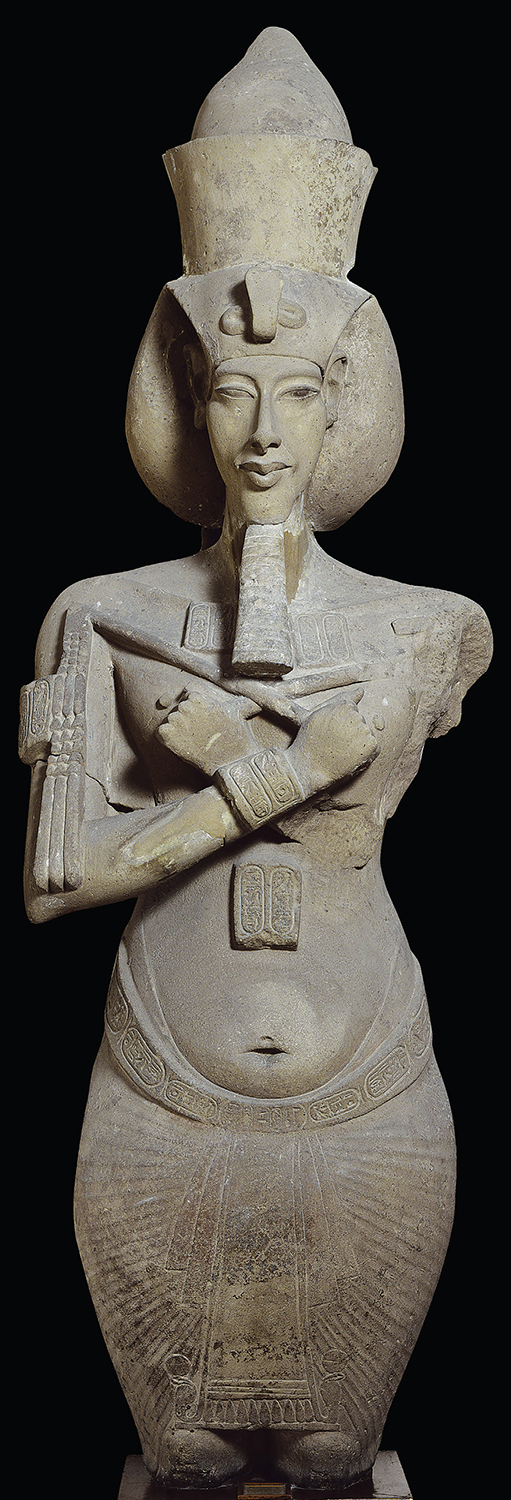
Who
Akhenaton
Statue with curved figure and weak arms
Temple of Aton, Karnak, Egypt
New Kingdom (Armana Period) (18th dynasty)
As a rebelious act against typical Egyptian art, possibly showing him as the sexless sun disk Aton
Sandstone

What
Akhenaton
Statue with curved figure and weak arms
Temple of Aton, Karnak, Egypt
New Kingdom (Armana Period) (18th dynasty)
As a rebelious act against typical Egyptian art, possibly showing him as the sexless sun disk Aton
Sandstone

Where
Akhenaton
Statue with curved figure and weak arms
Temple of Aton, Karnak, Egypt
New Kingdom (Armana Period) (18th dynasty)
As a rebelious act against typical Egyptian art, possibly showing him as the sexless sun disk Aton
Sandstone

When
Akhenaton
Statue with curved figure and weak arms
Temple of Aton, Karnak, Egypt
New Kingdom (Armana Period) (18th dynasty)
As a rebelious act against typical Egyptian art, possibly showing him as the sexless sun disk Aton
Sandstone

Why
Akhenaton
Statue with curved figure and weak arms
Temple of Aton, Karnak, Egypt
New Kingdom (Armana Period) (18th dynasty)
As a rebelious act against typical Egyptian art, possibly showing him as the sexless sun disk Aton
Sandstone

What material
Akhenaton
Statue with curved figure and weak arms
Temple of Aton, Karnak, Egypt
New Kingdom (Armana Period) (18th dynasty)
As a rebelious act against typical Egyptian art, possibly showing him as the sexless sun disk Aton
Sandstone
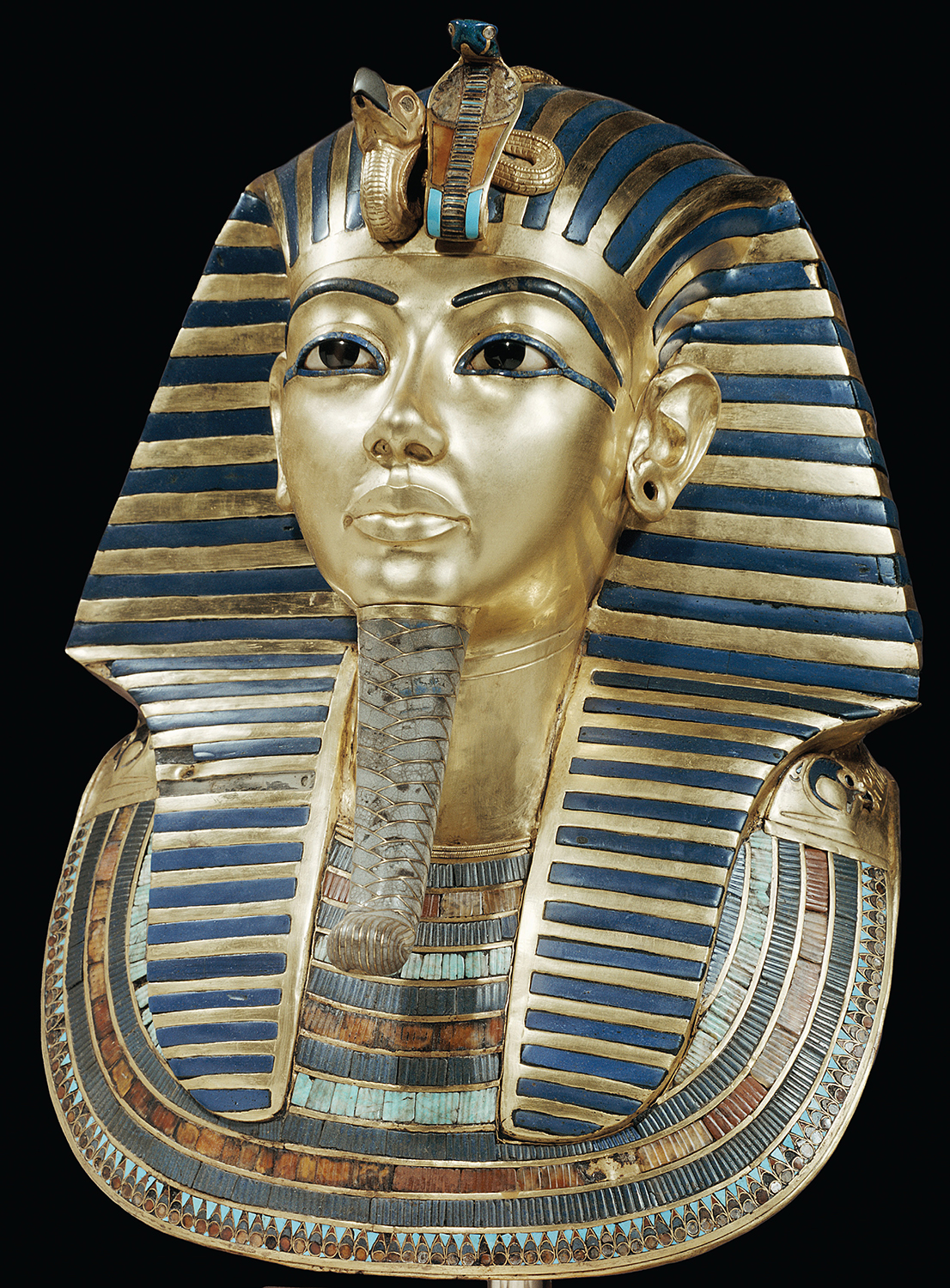
Who
Tutankhamen
Death mask of Tutankhamen
From the innermost coffin in his tomb at Thebes, Egypt
New Kingdom (Post Armana) (18th Dynasty)
A grandeur expression of Egyptian power and limitless wealth
Gold inlay with semiprecious stones

What
Tutankhamen
Death mask of Tutankhamen
From the innermost coffin in his tomb at Thebes, Egypt
New Kingdom (Post Armana) (18th Dynasty)
A grandeur expression of Egyptian power and limitless wealth
Gold inlay with semiprecious stones

Where
Tutankhamen
Death mask of Tutankhamen
From the innermost coffin in his tomb at Thebes, Egypt
New Kingdom (Post Armana) (18th Dynasty)
A grandeur expression of Egyptian power and limitless wealth
Gold inlay with semiprecious stones

When
Tutankhamen
Death mask of Tutankhamen
From the innermost coffin in his tomb at Thebes, Egypt
New Kingdom (Post Armana) (18th Dynasty)
A grandeur expression of Egyptian power and limitless wealth
Gold inlay with semiprecious stones

Why
Tutankhamen
Death mask of Tutankhamen
From the innermost coffin in his tomb at Thebes, Egypt
New Kingdom (Post Armana) (18th Dynasty)
A grandeur expression of Egyptian power and limitless wealth
Gold inlay with semiprecious stones

What material
Tutankhamen
Death mask of Tutankhamen
From the innermost coffin in his tomb at Thebes, Egypt
New Kingdom (Post Armana) (18th Dynasty)
A grandeur expression of Egyptian power and limitless wealth
Gold inlay with semiprecious stones
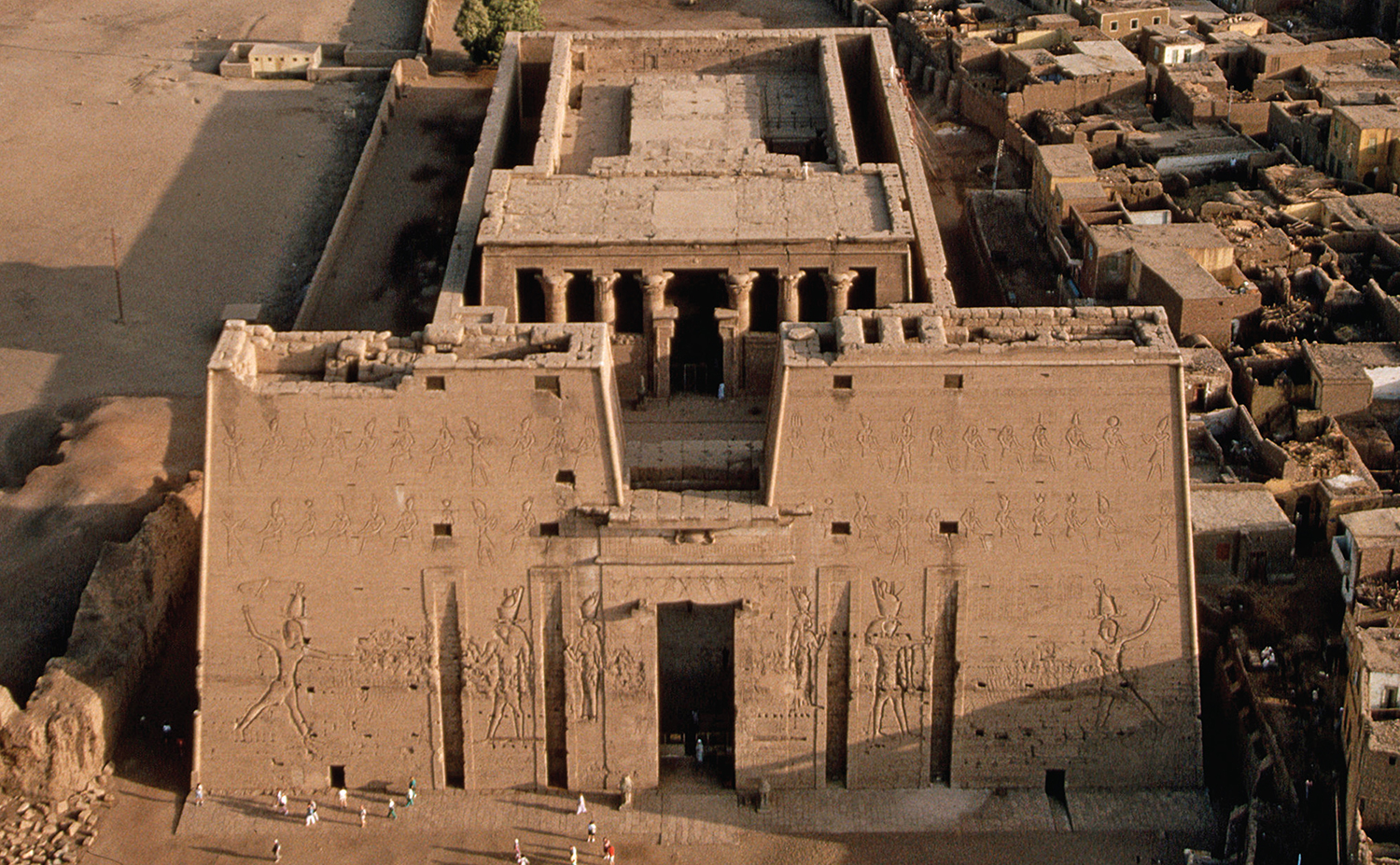
Who
King Ptolemy XIII and Cleopatra VII
Temple of Horus
Edfu, Egypt
First Millennium BCE
It follows the same basic architectural structure as the temple of Karnak a thousand years earlier

What
King Ptolemy XIII and Cleopatra VII
Temple of Horus
Edfu, Egypt
First Millennium BCE
It follows the same basic architectural structure as the temple of Karnak a thousand years earlier

Where
King Ptolemy XIII and Cleopatra VII
Temple of Horus
Edfu, Egypt
First Millennium BCE
It follows the same basic architectural structure as the temple of Karnak a thousand years earlier

When
King Ptolemy XIII and Cleopatra VII
Temple of Horus
Edfu, Egypt
First Millennium BCE
It follows the same basic architectural structure as the temple of Karnak a thousand years earlier

Why
King Ptolemy XIII and Cleopatra VII
Temple of Horus
Edfu, Egypt
First Millennium BCE
It follows the same basic architectural structure as the temple of Karnak a thousand years earlier
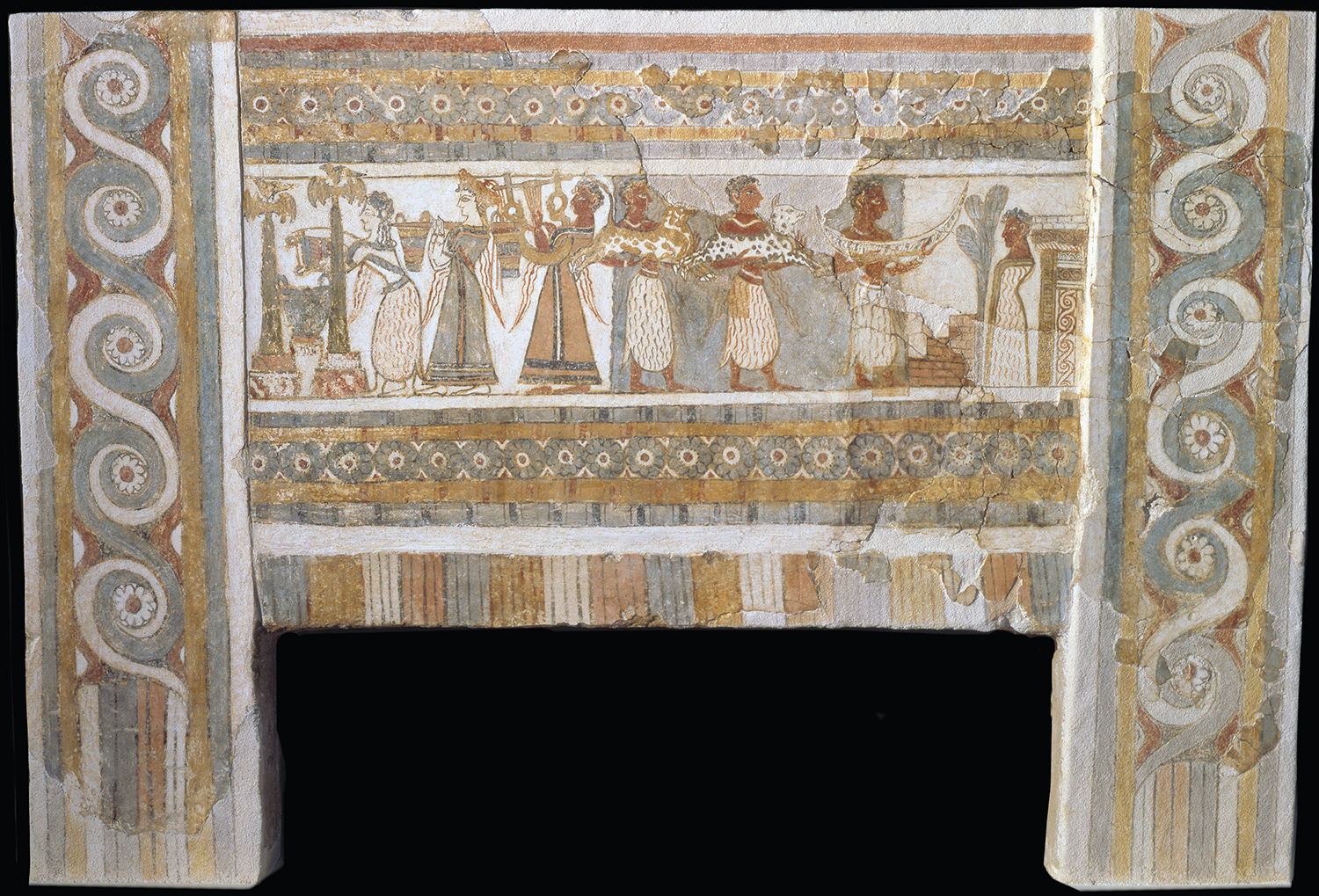
Who
The Minoans
Sarcophagus providing insight to Minoan rituals
Haga Triada (Crete)
Minaoan period (1,450-1,400 BC)
Provides insight to Minoan funerary rites and rituals
Painted limstone

What
The Minoans
Sarcophagus providing insight to Minoan rituals
Haga Triada (Crete)
Minaoan period (1,450-1,400 BC)
Provides insight to Minoan funerary rites and rituals
Painted limstone

Where
The Minoans
Sarcophagus providing insight to Minoan rituals
Haga Triada (Crete)
Minaoan period (1,450-1,400 BC)
Provides insight to Minoan funerary rites and rituals
Painted limstone

When
The Minoans
Sarcophagus providing insight to Minoan rituals
Haga Triada (Crete)
Minaoan period (1,450-1,400 BC)
Provides insight to Minoan funerary rites and rituals
Painted limstone

Why
The Minoans
Sarcophagus providing insight to Minoan rituals
Haga Triada (Crete)
Minaoan period (1,450-1,400 BC)
Provides insight to Minoan funerary rites and rituals
Painted limstone

What material?
The Minoans
Sarcophagus providing insight to Minoan rituals
Haga Triada (Crete)
Minaoan period (1,450-1,400 BC)
Provides insight to Minoan funerary rites and rituals
Painted limstone
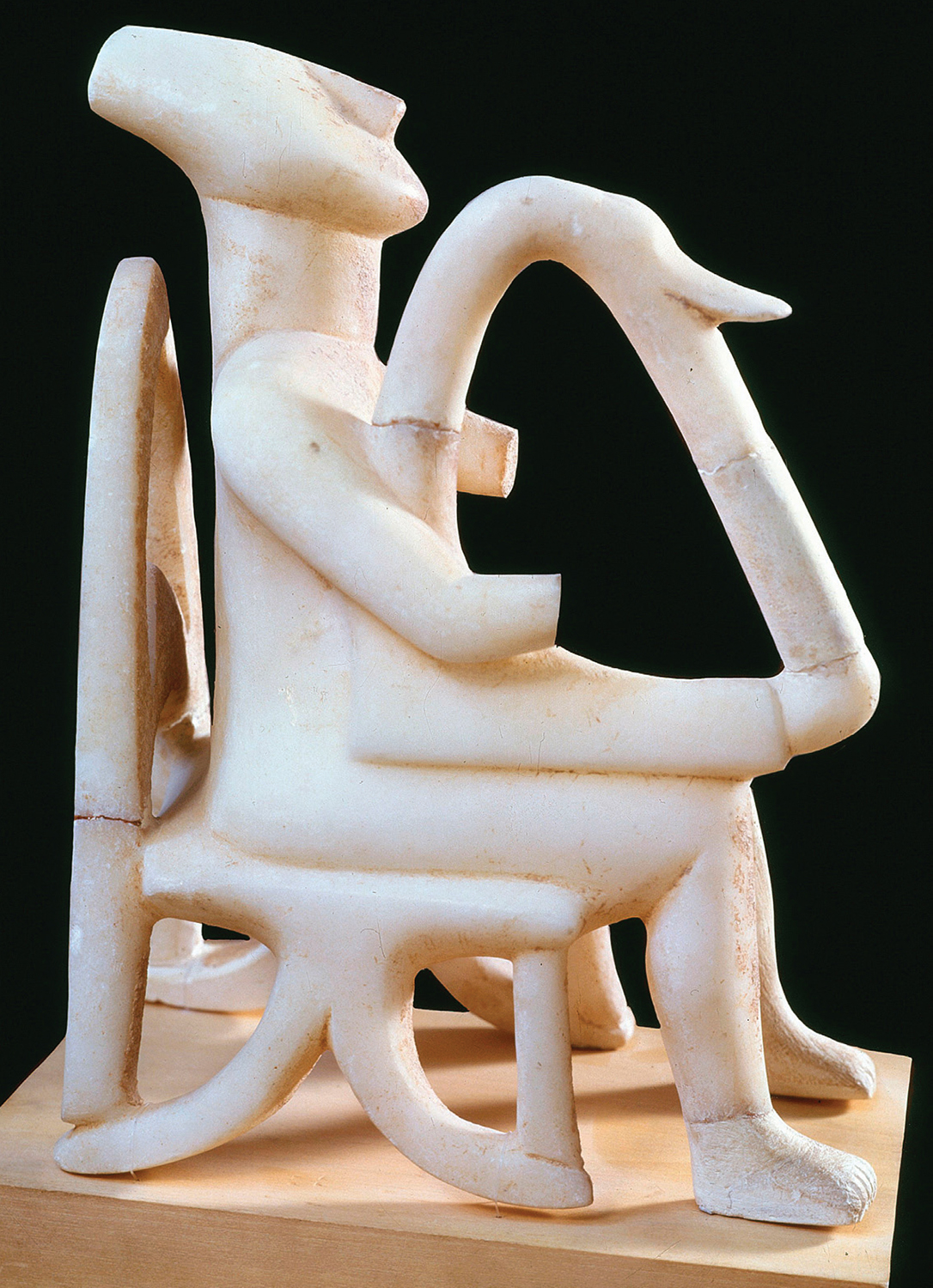
Who
Cycladeans
Figurine of seated musician playing harp maybe for deceased in afterlife
Keros (Cyclades) Grece
Cycladic Era 2,600-2,300 BC
Displays simple geometric shapes and flat planes
Marble

What
Cycladeans
Figurine of seated musician playing harp maybe for deceased in afterlife
Keros (Cyclades) Grece
Cycladic Era 2,600-2,300 BC
Displays simple geometric shapes and flat planes
Marble

Where
Cycladeans
Figurine of seated musician playing harp maybe for deceased in afterlife
Keros (Cyclades) Grece
Cycladic Era 2,600-2,300 BC
Displays simple geometric shapes and flat planes
Marble

When
Cycladeans
Figurine of seated musician playing harp maybe for deceased in afterlife
Keros (Cyclades) Grece
Cycladic Era 2,600-2,300 BC
Displays simple geometric shapes and flat planes
Marble

Why
Cycladeans
Figurine of seated musician playing harp maybe for deceased in afterlife
Keros (Cyclades) Grece
Cycladic Era 2,600-2,300 BC
Displays simple geometric shapes and flat planes
Marble

What material?
Cycladeans
Figurine of seated musician playing harp maybe for deceased in afterlife
Keros (Cyclades) Grece
Cycladic Era 2,600-2,300 BC
Displays simple geometric shapes and flat planes
Marble
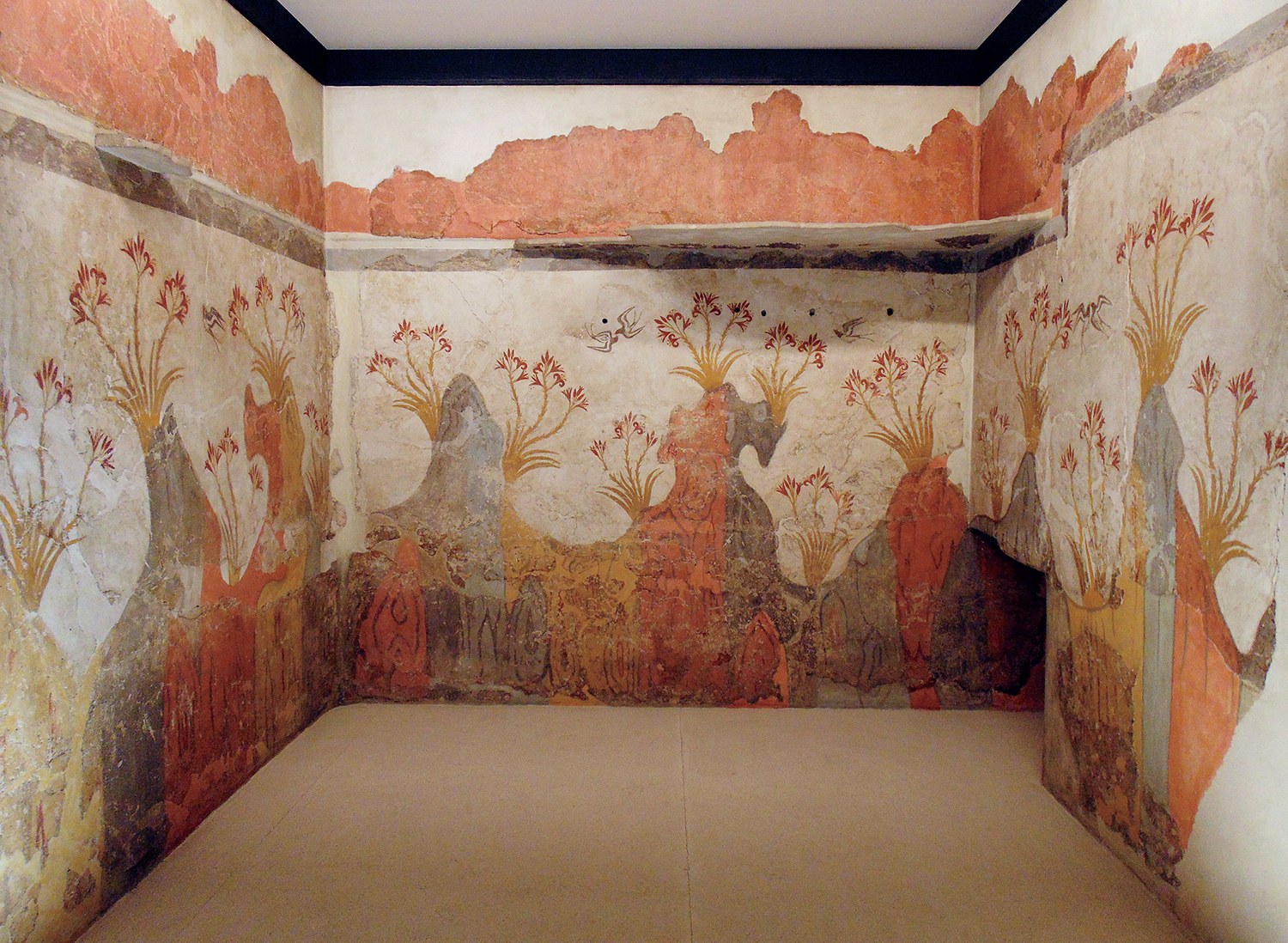
Who
Minoan muralists
Landscape with swallows (Spring Fresco)
Akrotiri, Thera (Cyclades), Greece
Minoan Period
Was preserved by a volcanic explosion that buried the land in ash. Its a true fresco capturing the essence of nature.
True Fresco

What
Minoan muralists
Landscape with swallows (Spring Fresco)
Akrotiri, Thera (Cyclades), Greece
Minoan Period
Was preserved by a volcanic explosion that buried the land in ash. Its a true fresco capturing the essence of nature.
True Fresco

Where
Minoan muralists
Landscape with swallows (Spring Fresco)
Akrotiri, Thera (Cyclades), Greece
Minoan Period
Was preserved by a volcanic explosion that buried the land in ash. Its a true fresco capturing the essence of nature.
True Fresco

When
Minoan muralists
Landscape with swallows (Spring Fresco)
Akrotiri, Thera (Cyclades), Greece
Minoan Period
Was preserved by a volcanic explosion that buried the land in ash. Its a true fresco capturing the essence of nature.
True Fresco

Why
Minoan muralists
Landscape with swallows (Spring Fresco)
Akrotiri, Thera (Cyclades), Greece
Minoan Period
Was preserved by a volcanic explosion that buried the land in ash. Its a true fresco capturing the essence of nature.
True Fresco

What material
Minoan muralists
Landscape with swallows (Spring Fresco)
Akrotiri, Thera (Cyclades), Greece
Minoan Period
Was preserved by a volcanic explosion that buried the land in ash. Its a true fresco capturing the essence of nature.
True Fresco
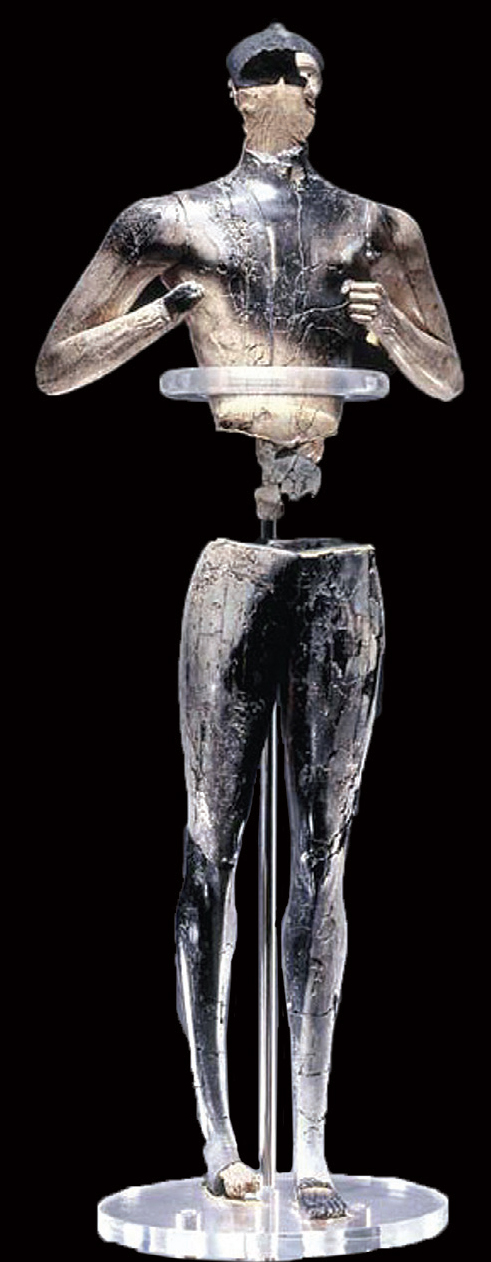
Who
Minoans
Chryselephantine sculpture of a young god
Palaikastro (Crete), Greece
Minoan Period (1500-1450)
Its a technique later used for the largest and costliest Greek cult statues.
Ivory, gold, serpentine, and rock crystal

What
Minoans
Chryselephantine sculpture of a young god
Palaikastro (Crete), Greece
Minoan Period (1500-1450)
Its a technique later used for the largest and costliest Greek cult statues.
Ivory, gold, serpentine, and rock crystal

Where
Minoans
Chryselephantine sculpture of a young god
Palaikastro (Crete), Greece
Minoan Period (1500-1450)
Its a technique later used for the largest and costliest Greek cult statues.
Ivory, gold, serpentine, and rock crystal

When
Minoans
Chryselephantine sculpture of a young god
Palaikastro (Crete), Greece
Minoan Period (1500-1450)
Its a technique later used for the largest and costliest Greek cult statues.
Ivory, gold, serpentine, and rock crystal

Why
Minoans
Chryselephantine sculpture of a young god
Palaikastro (Crete), Greece
Minoan Period (1500-1450)
Its a technique later used for the largest and costliest Greek cult statues.
Ivory, gold, serpentine, and rock crystal

What material
Minoans
Chryselephantine sculpture of a young god
Palaikastro (Crete), Greece
Minoan Period (1500-1450)
Its a technique later used for the largest and costliest Greek cult statues.
Ivory, gold, serpentine, and rock crystal
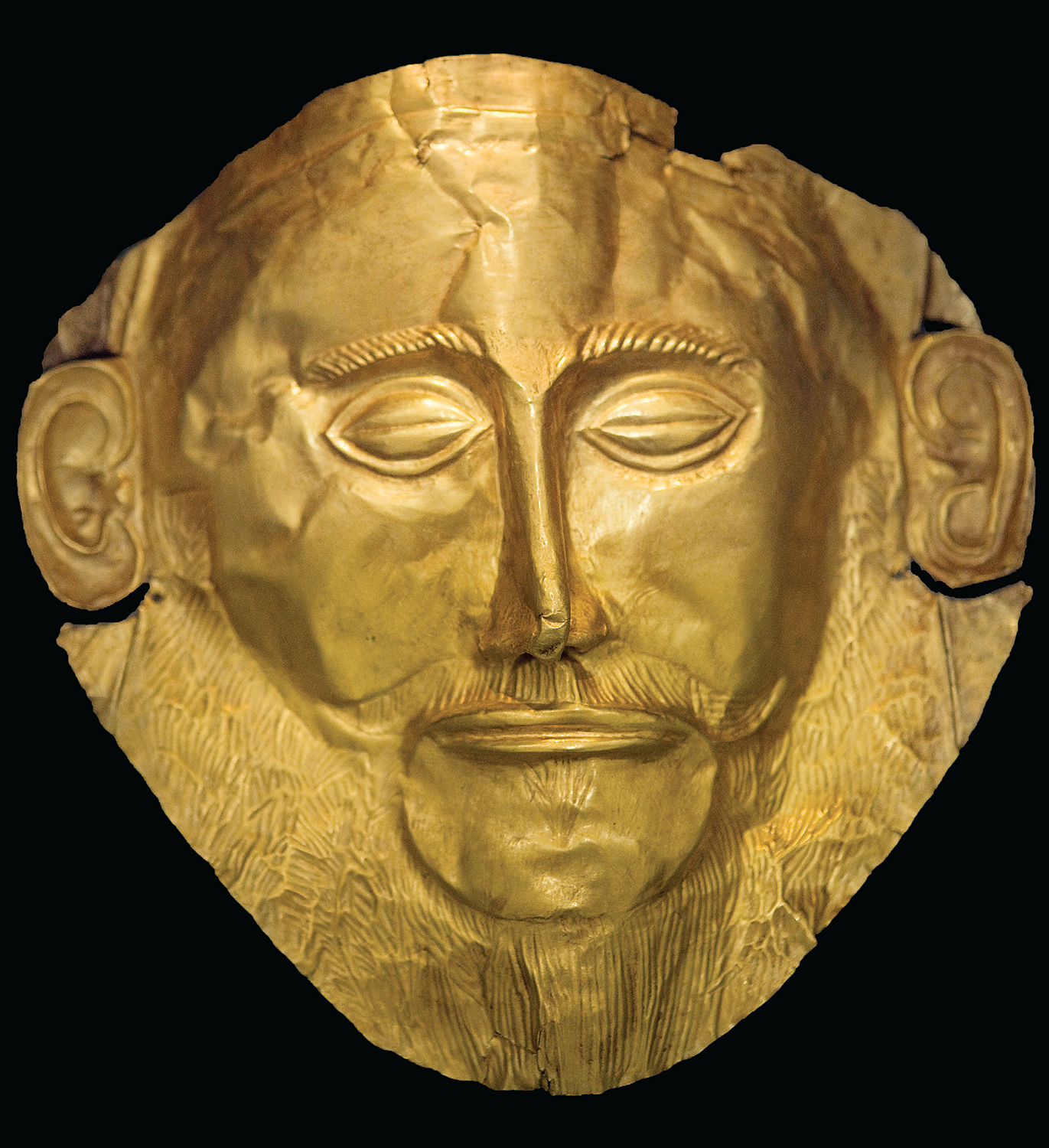
Who
Mycenaean metalworker
Gold repousse funerary mask from Grave Circle A
Grave Circle A, Mycenae, Greece
Mycenaean Period (1600-1500 BCE)
Possibly portraits of the dead. Showed the Mycenaeans were rich in gold way before Homer’s heros fought Troy.
Beaten Gold

What
Mycenaean metalworker
Gold repousse funerary mask from Grave Circle A
Grave Circle A, Mycenae, Greece
Mycenaean Period (1600-1500 BCE)
Possibly portraits of the dead. Showed the Mycenaeans were rich in gold way before Homer’s heros fought Troy.
Beaten Gold

Where
Mycenaean metalworker
Gold repousse funerary mask from Grave Circle A
Grave Circle A, Mycenae, Greece
Mycenaean Period (1600-1500 BCE)
Possibly portraits of the dead. Showed the Mycenaeans were rich in gold way before Homer’s heros fought Troy.
Beaten Gold